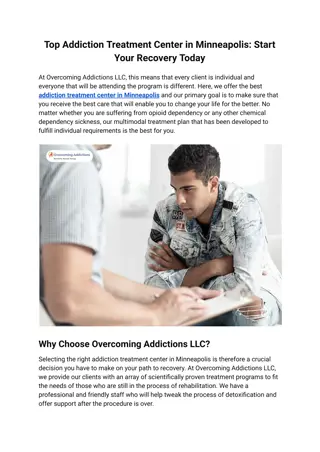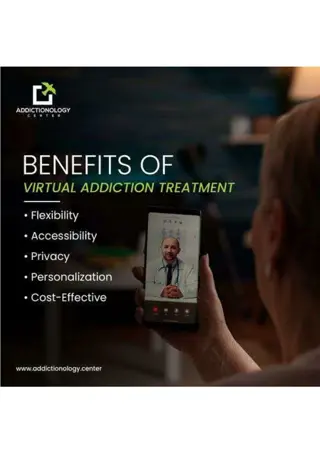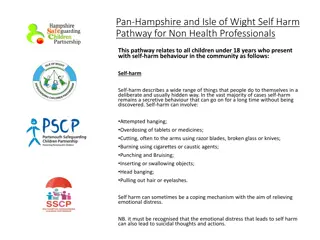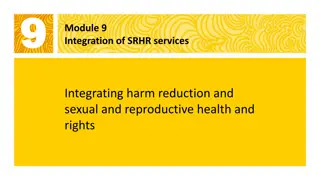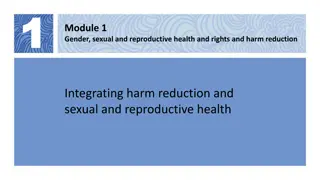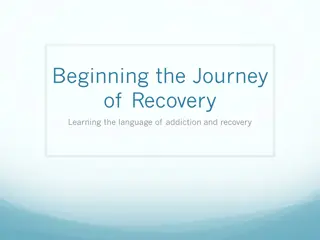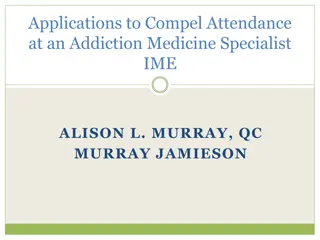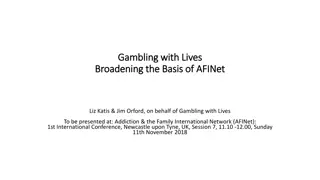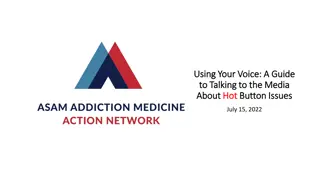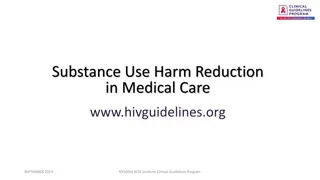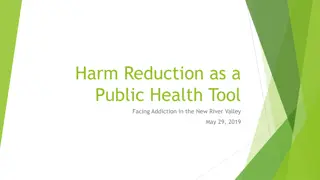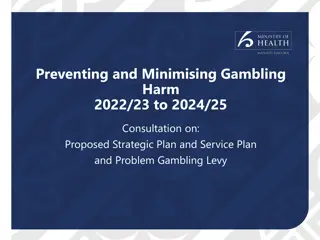Harm Reduction in Addiction Psychiatry: A Comprehensive Overview
Harm reduction in addiction psychiatry is a client-centered approach that focuses on reducing negative consequences associated with substance use. This philosophy involves practical strategies and principles aimed at promoting safer drug use practices. The historical background traces the evolution of harm reduction initiatives globally, highlighting key milestones and the increasing adoption of harm reduction programs. The objectives, definition, and role of clinicians in harm reduction are discussed to provide a thorough understanding of this vital practice in the field of psychiatry. Recommendations and conclusions are provided for enhancing harm reduction practices, emphasizing the importance of this approach in addressing public health challenges related to substance use.
Download Presentation

Please find below an Image/Link to download the presentation.
The content on the website is provided AS IS for your information and personal use only. It may not be sold, licensed, or shared on other websites without obtaining consent from the author. Download presentation by click this link. If you encounter any issues during the download, it is possible that the publisher has removed the file from their server.
E N D
Presentation Transcript
HARM REDUCTION IN ADDICTION PSYCHIATRY BY IYAMU CLEMENT OSASERE. FNPH, USELU. 15THFEBRUARY, 2023.
OUTLINE Objectives Introduction Definition Harm reduction strategies, goals and principles Current harm reduction practices Clinicians role in harm reduction Harm reduction practice in DATER, FNPN, Benin. Recommendations Conclusion References. 2
OBJECTIVES To explain the concept of harm reduction. To outline the goals, principles and current practices of harm reduction. To discuss the role of clinicians in harm reduction. 3
INTRODUCTION Harm reduction is client- centered philosophy that engages clients in the process of behavioural change even if they are not motivated to pursue abstinence from substance use. Often times abstinence is not feasible, so the need to practice safer ways of using drugs. Drug use has become a major public and mental health challenge of which we cannot shy away from. It is a therapy rather than a cure. 4
DEFINITION Harm reduction is a set of practical strategies and ideas aimed at reducing negative consequences associated with drug use. It is a movement for social justice built on a belief in, and respect for, the right of people who use drugs. 5
HISTORICAL BACKGROUND 1960s: -Emergence of controlled drinking . -Methadone maintenance treatment (Europe). -Grass-roots work on reducing harms. 1985: Australia adopted harm reduction as a national policy 1986: (UK) Needle and syringe exchange programs (NSEPs). - Endorsement of the underlying principles of harm reduction. (WHO, Stockholm) 1987: Similar programmes adopted in Denmark, Malta, Spain and Sweden. - Canadian government adopted harm reduction as a framework of the national drug strategy. 6
1989: First harm reduction project in Latin America (Brazil). 1990: NSEPs operated in 14 European countries. 1991: First needle exchange project in Asia (Nepal) by life saving and life giving organization. 2005: Methadone and Buprenorphine added to list of essential medicines by WHO. 2009: 31 Countries in Europe had NSEP, and 31 had opioid substitution therapy. 2020: 86 countries implement NSEPs and 86 have opioid substitution therapy (OST). 7
NIGERIA July- December 2020, first pilot study on NSEP. Implemented in Abia, Gombe and Oyo by the Drug Harm Reduction Advocacy Network (DHRAN). 8
GENERAL HARM REDUCTION STRATEGIES Education. Provision of a safe environment. Promotion of social and community support. Intervention to change high-risk behaviours. 9
GOALS OF HARM REDUCTION Minimize the harm associated with substance use. Minimize risk of: -Contracting infectious Disease. -Overdosing. Reduce negative outcome of drug use (e.g. violence, crime). Reduce harm to users families and the broader society. 10
PRINCIPLES OF HARM REDUCTION. 1. Accept that licit and illicit drug use is part of our world and chooses to work to minimise its harmful effects rather than simply ignore or condemn them. Drug use is a complex, multi-faceted phenomenon that encompasses severe use to total abstinence. Some ways of using drugs are clearly safer than others. Quality of life and well-being for the individual and community is the criteria for successful intervention and policies. 2. 3. 11
4. People who use drugs and the communities in which they live deserve non- judgemental, non- coercive services and resources in order to assist them in reducing harm. 5. Ensures that people who use drug and those with a history of drug use should have a voice in the creation of programs and policies designed to serve them. 6. Affirms people who use drug (PWUD) themselves as the primary agents of reducing the harms of their drug use and seeks to empower PWUD to share information and support each other in strategies which meet their actual condition of use. 12
7. Recognizes that the realities of poverty, class, racism, social isolation, past trauma, sex- based discrimination, and other social inequalities affect both peoples vulnerability to and capacity for effectively dealing with drug-related harm. 8. The real and tragic harm that can be associated with illicit drug use must not be minimized or ignored. 13
CURRENT HARM REDUCTION PRACTICES Education. Needle and syringe programmes (NSPs) Opioid substitution therapy (OST). Drug consumption rooms. Drug checking services (DCS). Prison needle and syringe programmes. Prison opioid substitution therapy. 14
EDUCATION A foremost harm reduction practice to educate PWUDs about Substance use disorder Overdose prevention STD prevention Blood borne viruses counselling 15
NEEDLE SYRINGE EXCHANGE PROGRAMME (NSEP) Needle exchange programme (NEP) Social services that allows injecting drug users to obtain clean and unused hypodermic needles and associated paraphernalia at little or no cost. Goal toward preventing blood borne disease in people who inject drugs (PWID) 16
OBJECTIVES 1. To reduce the practice of sharing of needles and syringes in IDUs. 2. To ensue availability and distribution of other injecting equipment, such as alcohol, swabs, distilled water. 3. To ensue retrieval of used equipment and increase the return rate of used injection equipment. 4. To promote safer sex practices and increase the use of condoms by IDUs. 17
5. To increase awareness about drug use, referrals, and access to drug treatment and PHC services. 6. To increase knowledge of IUDs and their sex partners about the risk of HIV infection. 18
PRINCIPLES OF SUCCESSFUL NSEP 1. Friendly and sensitive to the custom and culture of the community. 2. The delivery services should be respectful, non-judgemental, non- condemning and non- confrontational. 3. Promoting the principles of harm reduction and HIV prevention. 4. NSEP should work with community group to increase knowledge of IDUs and thereby promoting their acceptance in the community. 19
NSEP METHOD OF SERVICE DELIVERY. 1. Fixed- site model: stand- alone premises such as market, busy road, hospitals. 2. Outreach model: outreach workers and peers. Use mobile vans. 3. Satellite/secondary distribution centres: neighbourhood of IDUs, rural areas workers, pharmacies and local shops. 20
ESSENTIAL CONSIDERATION Ensure the provision of a full range of sterile injecting equipment. Consider providing other supplies. Consider differentiated service delivery. Establish a protocol for the collection and disposal of used needles and syringes. Ensure staff safety. 21
OTHER IMPORTANT SUPPLIES 1. Safe disposal boxes for used equipment. 2. Filters. 3. Tourniquets. 4. Sterile water. 5. Iodine and gauze for wound care. 6.Male and female condoms. 23
OPIOID SUBSTITUTION THERAPY (OST) Substitution therapy is the administration of under medical supervision of a prescribed substance, pharmaceutically related to the one producing dependence to people with substance dependence. For achieving defined therapeutic aims. OST is a form of health care for opiate dependent people using prescribed opioid agonist to help alleviate withdrawal symptoms and block the craving for illicit opiates. 24
Methadone maintenance treatment (MMT). Buprenorphine (partial agonist/mixed agonist-antagonist). 25
ESSENTIAL CONSIDERATION Develop a national clinical guideline for delivery of OST. Develop training. Offer psychosocial support to OST clients. Facilitate take-home dosages for patients. Consider differentiated service delivery. 26
ADVANTAGES OF METHADONE OVER HEROIN. Once daily dosage required. Cheaper than heroin. Unlikely to result in an overdose. Individual is stable while making life positive changes. Health problems are reduced or avoided. 27
ADVANTAGES OF BUPRENORPHINE OVER HEROIN. Unlikely to result in an overdose. Keeps individual stable while they make positive changes in their lives. Reduces health problems relating to injecting are reduced. Weekly or monthly dose required. 28
DRUG CONSUMPTION ROOMS Drug consumption rooms (DCRs) are professionally supervised healthcare facilities where people can consume illicit drug in a safe and non- judgemental environment. SERVICES Sterile injecting equipment. Counselling services. Emergency care. Primary medical care and referral. 29
OBJECTIVES Reduce high-risk injecting behaviour associated with HIV and viral hepatitis transmission. Reduces the incidence of overdose. Attracts population who may use drugs in risky and unhygienic conditions. Reduces public injecting. Facilitate links between people who use drugs and health and social services such as HIV and viral hepatitis testing, housing, employment support . 1. 2. 3. 4. 5. 30
DRUG CHECKING SERVICES Developed in the 1980s. A harm reduction intervention that allow the public to submit drug samples from unregulated drug market for chemical analysis. To enable PWUD to know the composition of what is in their drug and potentially take actions to reduce the risk of associated harm. 31
SUBSTANCE-SPECIFIC HARM REDUCTION PRACTICES ALCOHOL 1. Campaigns against drinking and driving. 2. Brief interventions and advice for problematic drinkers, pregnant women, or young people. 3. Thiamine supplements to reduce brain damage. 4. Serving alcohol in shatter- proof glass to prevent injuries. 5. Sobering- up shelters for heavily intoxicated individuals or homeless drinkers. 32
TOBACCO 1. Reduced- exposure products. 2. Reducing consumption. 3. Long- term nicotine replacement therapy (e.g. e-cigarettes). 4. Smokeless tobacco products (e.g. dry/ moist snuff). 5. Using replacement products for temporary abstinence (e.g. Nicotine patches). 33
CLINICIANS ROLE IN HARM REDUCTION Help in dissemination of information and materials about harm reduction, and development of scientific and the regulatory frameworks needed to deliver harm reduction interventions. Familiar with, open and up to date information on harm reduction principles and interventions. Help promote the interventions through partnerships with various stakeholders. 34
HARM REDUCTION PRACTICE IN DATER UNIT, FNPH, USELU GENERAL HARM REDUCTION PRACTICES Education on: -Substance use disorders. -Overdose prevention. -STD prevention. -Blood Borne Viruses (BBV) counselling and testing. 35
SPECIFIC HARM REDUCTION PRACTICES 1. Alcohol: -Brief intervention for problematic drinking. -Thiamine supplement. 2. Tobacco: -Nicotine replacement therapy. (patch and gum) 3. Injecting drug use: -Education on overdose prevention, HBV counselling and testing. 4. Opioid substitution therapy (OST): Development of national clinical guidelines for OST delivery by the United Nation Office on Drug and Crime (UNODC). 36
RECOMMENDATIONS Address stigmatization and discrimination. Removing human rights-related barriers to access. Drug law reform toward ending criminalization of drug use. Community involvement and community systems strengthening. 37
CONCLUSION Since the mid-1980s, harm reduction has transformed and evolved in different parts of the world. As the rate of use of drugs is becoming alarming, the need for safer drug use practices cannot be over- emphasized. There is great need for these services to be non- discriminatory, non- judgmental and the need to protect the rights of people who use drugs (PWUDs) to health. However, Nigeria is still far behind most countries in harm reduction practice and policy. Harm reduction save life and the responsibility falls on everyone so the aim of the policy is not defeated. 38
REFERENCES 1. Harm Reduction International [Internet]. Available from: https://www.hri.global/ 2. Cook C, Bridge J, Stimson G V. The diffusion of harm reduction in Europe and beyond. EMCDDA Monogr Hard Reduct evidence, impacts, challenges [Internet]. 2010;37 51. 3. International HR. The Global State Of Harm Reduction 2020. SpringerReference. 2020; 4. GlobalFund TG. Harm reduction for people who use drugs. 2020;(March). 5. International HR. Harm reduction for stimulant use. 2019;(April). 6.UNODC, 2012. Needle syringe exchange program for IDUs 39
7. European Monitoring Centre for Drugs and Drug Addiction. Drug Consumption Rooms: An Overview of Provisions and Evidence. Perspect Drugs [Internet]. 2018;1 8. 8. NACA. An Assessment of the Pilot Needle and syringe programme for People Who Inject Drugs in Nigeria. 2021;(April). 9. Prison needle exchange: lesson from a comprehensive review of international evidence and experience, 2nd edition, 2006. 10. Harm reduction international. Global state of harm reduction 2018 briefing. Drug consumption room 11. Journal of food and drug analysis: Harm reduction history, response, current trends in Asia 40








